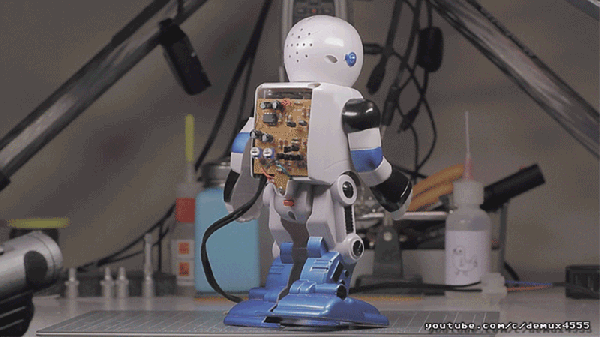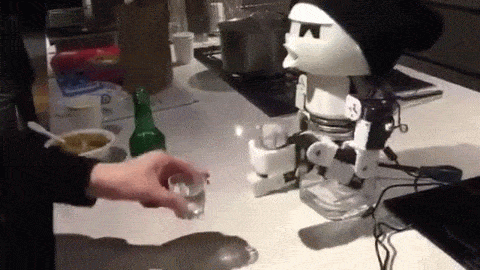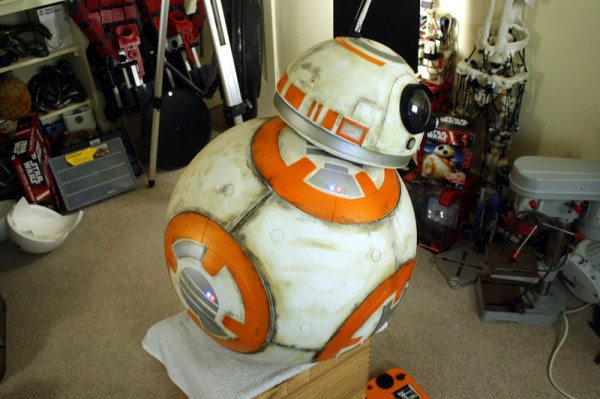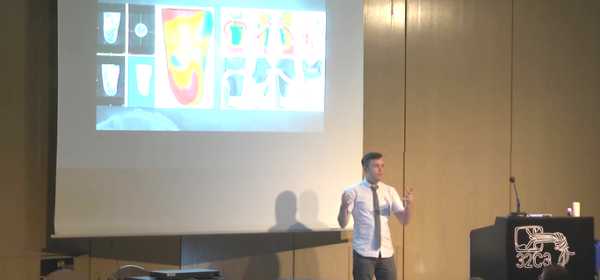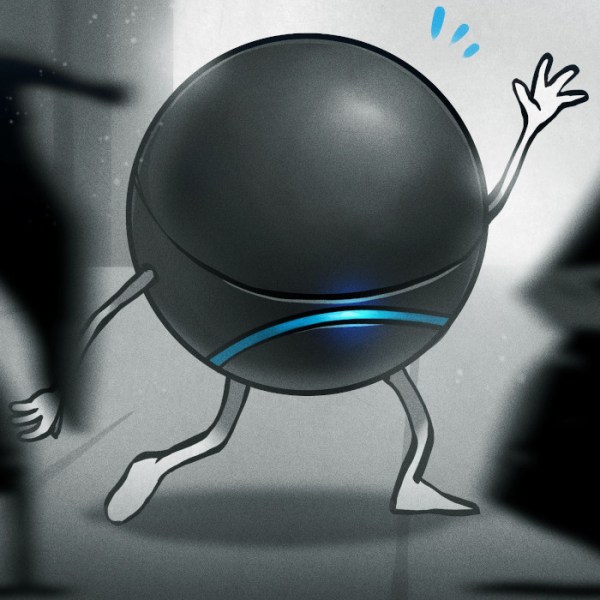If you watch science fiction movies, the robots of the future look like us. The truth is, though, many tasks go better when robots don’t look like us. Sometimes they are unique to a particular job or sometimes it is useful to draw inspiration from something other than a human being. One professor at Johns Hopkins along with some students decided to look at spider crickets as an inspiration for a new breed of jumping robots.
Robots Hacks2367 Articles
Robotic Suitcase Follows You Around
I have something that follows me around all the time: my dog Jasper. His cargo-carrying capability is limited, though, and he requires occasional treats. Not so this robotic suitcase. All it needs, the designers claim, is an occasional charge and a Bluetooth device to follow.
Designed by NUA Robotics, this suitcase is equipped with powered wheels and a certain amount of smarts: enough to figure out the direction of a Bluetooth signal such as your cell phone and follow it. This is also accompanied by proximity sensors so it doesn’t bump into you or other people. When the built-in battery runs out, just pop put the handle and pull it yourself, and the regenerative motors will recharge the battery. There’s no indication on price, battery life or how much space is left to actually carry stuff yet, but the designers claim it could be out within the year. As someone who uses a walking stick, this sounds like a great idea. And if they can work out how to get it to walk the dog for me, that would be even better.
Now, who will be the first to build a clone of this in their basement? Bonus points if it’s a two-wheeled self-balancer.
Crappy Robots And Even Crappier Electronics Kits
Robots and DIY electronics kits have a long history together. There probably isn’t anyone under the age of forty that hasn’t had some experience with kit-based robots like wall-hugging mouse robots, a weird walking robot on stilts, or something else from the 1987 American Science and Surplus catalog. DIY robot kits are still big business, and walking through the sales booths of any big Maker Faire will show the same ideas reinvented again and again.
[demux] got his hands on what is possibly the worst DIY electronics kit in existence. It’s so incredibly bad that it ends up being extremely educational; pick up one of these ‘introduction to electronics’ kits, and you’ll end up learning advanced concepts like PCB rework, reverse engineering, and Mandarin.
Continue reading “Crappy Robots And Even Crappier Electronics Kits”
Drinking With Your Robot
We’ve seen tons of bartending robots before, but we’re not sure we’ve ever seen a robot that actually drinks with you… Until now anyway.
Designed and built by a South Korean inventor, [Eunchan Park], he built this robot to drink with, quite literally.
The story goes that he tried drinking alone in 2012 because he did not have a girlfriend at the time. He didn’t enjoy drinking alone and promptly stopped. But then recently he tried drinking with two glasses on the table, and cheers himself when drinking. According to him, the alcohol tasted much better that way, which drove him to build Drinky, the Alcohol Drinking Robot.
Very Detailed BB-8 Robot Build
[James Bruton] has just finished and posted the designs for his very impressive BB-8 robot build. We covered the start of his adventures some time ago when we were theorizing about the secret in the new droid, but it was for a completely different robot design. [James] was pursuing a design that used a little robot sitting on top of a big ball.
This new version has a robot sitting inside a ball with the head being magnetically coupled to the body. Among many things with this build, we thought it was cool how the robot has one drive motor and turns by spinning up and reversing a big flywheel in the base of the robot. That was certainly not one of the top theories proposed for the secret behind the robot. The robot is mostly made with a 3d printer, with the occasional cosmetic piece being vacuum formed. If you’d like to make one for yourself, [James] has also posted all of the design and cad for the robot on his GitHub. On Thursday he posted the final installment of his 10-part video series on the build. Check out part one after the break.
32C3: 3D Printing On The Moon
How do you resist this talk title? You can’t! [Karsten Becker]’s talk about what kinds of 3D printers you’d use on the moon is a must-see.
[Part-Time Scientists] was a group of 35 people working on a mission to the moon. Then they won the qualifying round in the Google Lunar XPRIZE, got a bunch of money, and partnered with some heavy corporate sponsors, among which is Audi. Now they’ve added eleven full-time employees and updated the name to [PT Scientists]. (They’re taking applications if you’re interested in helping out!)
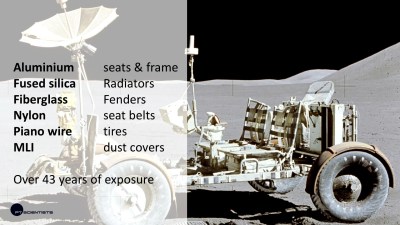 A really neat part of their planned mission is to land near the Apollo 17 landing site, which will let them check up on the old lunar rover that NASA left up there last time. The science here is that, 45 years on, they hope to learn how all of the various materials that make up the rover have held up over time.
A really neat part of their planned mission is to land near the Apollo 17 landing site, which will let them check up on the old lunar rover that NASA left up there last time. The science here is that, 45 years on, they hope to learn how all of the various materials that make up the rover have held up over time.
But the main attraction of their mission is experimental 3D printing using in-situ materials. As [Karsten] says, “3D printing is hard…but we want to do it on the moon anyway.”
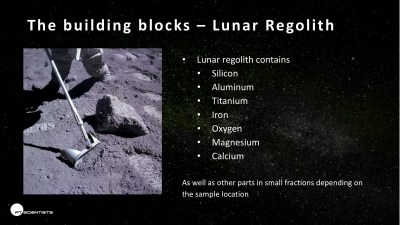 One idea is to essentially microwave the lunar regolith (and melt it) . This should work because there’s a decent iron component in the regolith, so if they can heat it up it should fuse. The catch with microwaving is directivity — it’s hard to make fine details. On the plus side, it should be easy to make structures similar to paved roads out of melted regolith. Microwave parts are robust and should hold up to launch, and microwaving is relatively energy efficient, so that’s what they’re going to go for.
One idea is to essentially microwave the lunar regolith (and melt it) . This should work because there’s a decent iron component in the regolith, so if they can heat it up it should fuse. The catch with microwaving is directivity — it’s hard to make fine details. On the plus side, it should be easy to make structures similar to paved roads out of melted regolith. Microwave parts are robust and should hold up to launch, and microwaving is relatively energy efficient, so that’s what they’re going to go for.
But there are other alternatives. The European Space Agency is planning to bring some epoxy-like binder along, and glue regolith together in layers like a terrestrial cement printer. The problem is, of course, schlepping all of the binder to the moon in the first place.
And then there are lasers. [Karsten] talked lasers down a little bit, because they’re not very energy efficient and the optics are fidgety — not something you’d like to be supporting remotely from earth.
The final option that [Karsten] mentioned was the possibility of using locally-generated thermite to fuse regolith. This has been tested out on earth, and should work. [Karsten] thought it was an interesting option, but balls of hot thermite are potentially tough on rovers, and the cost of mistakes are so high that they’re going to put that off for a future mission.
In the end, the presentation ran only thirty minutes long, so there’s a great Q&A session after that. Don’t go home once you hear the audience clapping!
32C3: My Robot Will Crush You With Its Soft Delicate Hands!
In his talk at 32C3 [Matthew Borgatti] talked both about his company’s work with NASA toward developing robotic spacesuits and helping people with Cerebral Palsy better control their limbs. What do these two domains have in common? “One-size fits all pneumatic exoskeletons.”
[Matthew] makes a tremendously compelling case for doing something new and difficult in robotics — making robotic systems out of squishy, compliant materials. If you think about it, most robots are hard: made of metal and actuated by motors and gears, cables, or (non-compressible) pneumatic fluid. If you want to build suits that play well with soft and squishy people, they’ll need at least a layer of softness somewhere.
But [Matthew]’s approach is to make everything soft. In the talk, he mentions a few biological systems (octopus arms and goat’s feet) that work exactly because they’re soft. Why soft? Because soft spreads force around automatically and accommodates uneven terrain. And this makes it easier on the people who wear robotic suits and on the designers of the robots who don’t need to worry about the fine detail of the ground they’re walking on.
The talk ended up being very short, but there’s a fantastic Q&A at the end. It’s a must-see. And if you can’t get enough of [Matthew] or squishy robots, we’ve covered his robots before and he even had an entry in the Hackaday Prize.



